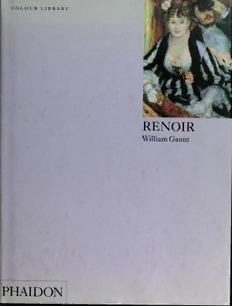
Renoir PDF
Preview Renoir
COLOUR LIBRARY RENOIR William Gaunt PHAIDON RENOIR RENOIR William Gaunt with notes by Kathleen Adler Phaidon Press Limited 2 Kensington Square, London \V8 SEP First published 1962 This edition, revised and enlarged, first published 1982 Fourth impression 1992 This hardback edition first published 1994 © 1982 Phaidon Press Limited A CIP catalogue record for this book is available from the British Library ISBN 7148 3230 8 All rights reserved. No part of this publication may be reproduced, stored in a retrieval system, or transmitted, in any form or by any means, electronic, mechanical, photocopying, recording or otherwise, without the prior permission ofPhaidon Press. Printed in Singapore The publishers wish to thank all private owners, museums, galleries and other institutions for permission to reproduce works in theircollec- tions. Particular acknowledgement is made for the following: Plate 1 - Courtesy of the Fogg Art Museum, Harvard University, Cambridge, Mass. Bequest- Grenville L. Winthorp; Fig. 1 - Courtesy ofthe Fogg Art Museum, Har\ard I ni\ersity. Bequest - Collection of Maurice Wertheim. Plates 9, 30, 39, 45 and Fig. 33 - Reproduced by courtesy of the Trustees, The National Gallery, London. Fig. 28 - Photograph Copyright (1982) by The Barnes Foundation, Merion, P.A. Fig. 11 - Allen Memorial Art Museum, Oberlin College, Ohio. R.T. Miller, Jr. Fund, 48.296. Plates 3, 12, 20, 25, 26, 31, 37, 42, 47, 48 and Figs. 4, 6, 7, 15 and 34-Musee du Louvre, Paris. Fig. 23 -Museum ofArt, Carnegie Institute, Pittsburgh, Pennsylvania; Acquired through the generosity ofMrs Alan M. Scaife and family, 1965. Cover illustrations: (front) LaLoge. 1874. (Plate; 16) (back) TheEndoftheLunch. 1879. (Plate 34) Renoir Renoir the name of the great French painter (in itself hke a sigh . . . of pleasure) calls up an entrancing world in which the women and children are entirely captivating, the sun-flushed bathers, splendid of body, seem to belong to a new golden age, the landscapes shimmer with intoxicating light and colour, the everyday scene the artist knew is endowed, by his perception, with a wonderfully joyous and gracious life. He is born into the nineteenth centur\% yet he has banished from it all that is stern and sombre, awkward and ugly. This is the effect of a temperament, an outlook, he shares, in some degree, with other members of that remarkable group with whom he is associated, the Impressionists, whose concurrence is so beautiful an episode in the historv," of art. His creativeness, however, is not confined by the formulas ofa 'movement'. He is like an artist ofthe eighteenth centurv,-, of the time of Boucher and Fragonard. reborn in the bourgeois epoch. He admires and conserxes, it is the nature of his gift to express, the exquisite refinement of the French tradition. On the other hand he marches forward into the twentieth centurs"; his art in his old age. when, though crippled in body, he is more vigorous than ever in spirit, puts out new and rich blooms. To trace this magnificent evolution let us first mentally transport ourselves to Paris ofa little more than a hundred years ago and enterthe workshop ofa china manufacturer in the rue du Temple. Here, in 1854. sat Pierre-Auguste Renoir, a slight, brown-eyed boy. thirteen years of age, industriously painting sprays of flowers on the smooth white surface ofcup and saucer. It was his start in life, for which he had to thank the peculiar respect the porcelain industry" inspired in his parents. They came from Limoges, where porcelain stood for prestige and prosperity. In their view it offered an ideal niche for a son who wished to be an 'artist". The father of Pierre-Auguste. Leonard Renoir, was a 'modest artisan', a struggling tailor, that is, who had been unsuccessful in Limoges and in middle age had come, with wife and children, to tr\" his luck in the capital. Pierre-.A.uguste was born in Limoges in 1841, but as the move was made when he was only four he had no memories ofhis native cirs* and ne\er again set foot there. To all intents and purposes he was a young Parisian of the working class. It would seem that the first known Renoir of the line (Francis) was a foundling, but born in 1773, married in the revolutionarv," Year I\' (1795), becoming the father of Leonard in the Year \'II. The first impressions of our Renoir were of humble quarters in the rue d'Argenteuil. He went to the state school, where the choirmaster of St Eustache, Charles Francois Gounod, who gave music lessons (he was not yet famous as a composer), picked him out as one with the makings of a singer: but the symptom familiar in the early life of most artists showed itself. He covered the pages of his exercise books with drawings; his parents gave his bent as practical a turn
